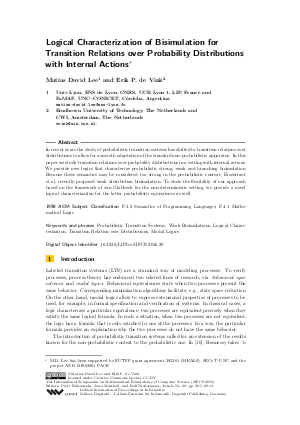Logical Characterization of Bisimulation for Transition Relations over Probability Distributions with Internal Actions
Authors Matias David Lee, Erik P. de Vink
-
Part of:
Volume:
41st International Symposium on Mathematical Foundations of Computer Science (MFCS 2016)
Part of: Series: Leibniz International Proceedings in Informatics (LIPIcs)
Part of: Conference: Mathematical Foundations of Computer Science (MFCS) - License:
 Creative Commons Attribution 3.0 Unported license
Creative Commons Attribution 3.0 Unported license
- Publication Date: 2016-08-19
File

PDF
LIPIcs.MFCS.2016.29.pdf
- Filesize: 0.55 MB
- 14 pages
Document Identifiers
Subject Classification
Keywords
- probabilistic transition systems
- weak bisimulations
- logical characterization
- transition relation over distributions
- modal logics
Metrics
- Access Statistics
-
Total Accesses (updated on a weekly basis)
0Document
0Metadata
Abstract
In recent years the study of probabilistic transition systems has shifted to transition relations over distributions to allow for a smooth adaptation of the standard non-probabilistic apparatus. In this paper we study transition relations over probability distributions in a setting with internal actions. We provide new logics that characterize probabilistic strong, weak and branching bisimulation. Because these semantics may be considered too strong in the probabilistic context, Eisentraut et al. recently proposed weak distribution bisimulation. To show the flexibility of our approach based on the framework of van Glabbeek for the non-deterministic setting, we provide a novel logical characterization for the latter probabilistic equivalence as well.
Cite As Get BibTex
Matias David Lee and Erik P. de Vink. Logical Characterization of Bisimulation for Transition Relations over Probability Distributions with Internal Actions. In 41st International Symposium on Mathematical Foundations of Computer Science (MFCS 2016). Leibniz International Proceedings in Informatics (LIPIcs), Volume 58, pp. 29:1-29:14, Schloss Dagstuhl – Leibniz-Zentrum für Informatik (2016)
https://doi.org/10.4230/LIPIcs.MFCS.2016.29
BibTex
@InProceedings{lee_et_al:LIPIcs.MFCS.2016.29,
author = {Lee, Matias David and de Vink, Erik P.},
title = {{Logical Characterization of Bisimulation for Transition Relations over Probability Distributions with Internal Actions}},
booktitle = {41st International Symposium on Mathematical Foundations of Computer Science (MFCS 2016)},
pages = {29:1--29:14},
series = {Leibniz International Proceedings in Informatics (LIPIcs)},
ISBN = {978-3-95977-016-3},
ISSN = {1868-8969},
year = {2016},
volume = {58},
editor = {Faliszewski, Piotr and Muscholl, Anca and Niedermeier, Rolf},
publisher = {Schloss Dagstuhl -- Leibniz-Zentrum f{\"u}r Informatik},
address = {Dagstuhl, Germany},
URL = {https://drops.dagstuhl.de/entities/document/10.4230/LIPIcs.MFCS.2016.29},
URN = {urn:nbn:de:0030-drops-64441},
doi = {10.4230/LIPIcs.MFCS.2016.29},
annote = {Keywords: probabilistic transition systems, weak bisimulations, logical characterization, transition relation over distributions, modal logics}
}
Author Details
References
-
J.C.M. Baeten and R. J. van Glabbeek. Another look at abstraction in process algebra. In T. Ottmann, editor, Proc. ICALP'87, pages 84-94. LNCS 267, 1987.

-
S. Crafa and F. Ranzato. Logical characterizations of behavioral relations on transition systems of probability distributions. TOCL, 16(1):2:1-24, 2014.

-
P.R. D'Argenio and M.D. Lee. Probabilistic transition system specification: Congruence and full abstraction of bisimulation. In L. Birkedal, editor, Proc. FOSSACS 2012, 2012.

-
P.R. D'Argenio, M.D. Lee, and D. Gebler. SOS rule formats for convex and abstract probabilistic bisimulations. In S. Crafa et al., editor, Proc. EXPRESS/SOS 2015, 2015.

-
Y. Deng and M. Hennessy. On the semantics of Markov automata. Information and Computation, 222:139-168, 2013.

-
Y. Deng, R. J. van Glabbeek, M Hennessy, and C. Morgan. Characterising testing preorders for finite probabilistic processes. Logical Methods in Computer Science, 4(4), 2008.

-
Y. Deng and R.J. van Glabbeek. Characterising probabilistic processes logically. CoRR, abs/1007.5188, 2010.

-
J. Desharnais, V. Gupta, R. Jagadeesan, and P Panangaden. Weak bisimulation is sound and complete for PCTL^*. Information and Computation, 208(2):203-219, 2010.

-
C. Eisentraut, H. Hermanns, J. Krämer, A. Turrini, and L. Zhang. Deciding bisimilarities on distributions. In Joshi, K.R. et al., editor, Proc. QEST 2013, pages 72-88, 2013.

-
M. Hennessy. Exploring probabilistic bisimulations, part I. Formal Aspects of Computing, 24(4-6):749-768, 2012.

-
H. Hermanns, J. Krcál, and J. Kretínský. Probabilistic bisimulation: Naturally on distributions. In P. Baldan and D. Gorla, editors, Proc. CONCUR 2014, pages 249-265, 2014.

-
H. Hermanns, A. Parma, R. Segala, B. Wachter, and L. Zhang. Probabilistic logical characterization. Information and Computation, 209(2):154-172, 2011.

-
K.G. Larsen and A. Skou. Bisimulation through probabilistic testing. Information and Computation, 94(1):1-28, 1991.

-
N.A. Lynch, R. Segala, and F.W. Vaandrager. Observing branching structure through probabilistic contexts. SIAM Journal of Computing, 37(4):977-1013, 2007.

- M. Mio. Upper-expectation bisimilarity and Łukasiewicz μ-calculus. In A. Muscholl, editor, Proc. FoSSaCS, pages 335-350, 2014. URL: http://dx.doi.org/10.1007/978-3-642-54830-7_22.
-
M. Mio and A.K. Simpson. Łukasiewicz μ-calculus. CoRR, abs/1510.00797, 2015.

-
A. Parma and R. Segala. Logical characterizations of bisimulations for discrete probabilistic systems. In H. Seidl, editor, Proc. FOSSACS 2007, pages 287-301. LNCS 4423, 2007.

-
J. Sack and L. Zhang. A general framework for probabilistic characterizing formulae. In VMCAI 2012, Philadelphia, USA, January, 2012. Proceedings, pages 396-411, 2012.

-
L. Song, L. Zhang, and J.C. Godskesen. Bisimulations meet PCTL equivalences for probabilistic automata. Logical Methods in Computer Science, 9(2), 2013.

-
M.I.A. Stoelinga. Alea jacta est: verification of probabilistic, real-time and parametric systems. PhD thesis, Radboud Universiteit Nijmegen, 2002.

-
R. J. van Glabbeek. The linear time-branching time spectrum II. In E. Best, editor, Proc. CONCUR '93, pages 66-81. LNCS 715, 1993.

-
R. J. van Glabbeek and W. P. Weijland. Branching time and abstraction in bisimulation semantics. Journal of the ACM, 43(3):555-600, 1996.

